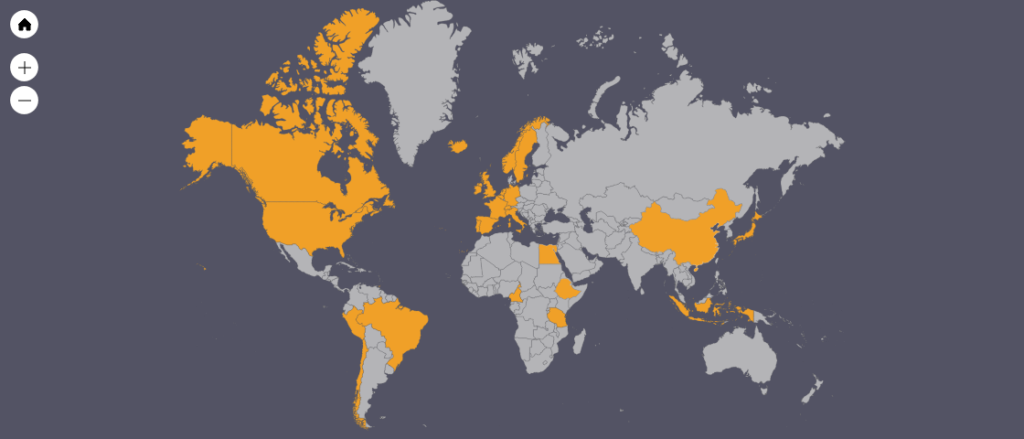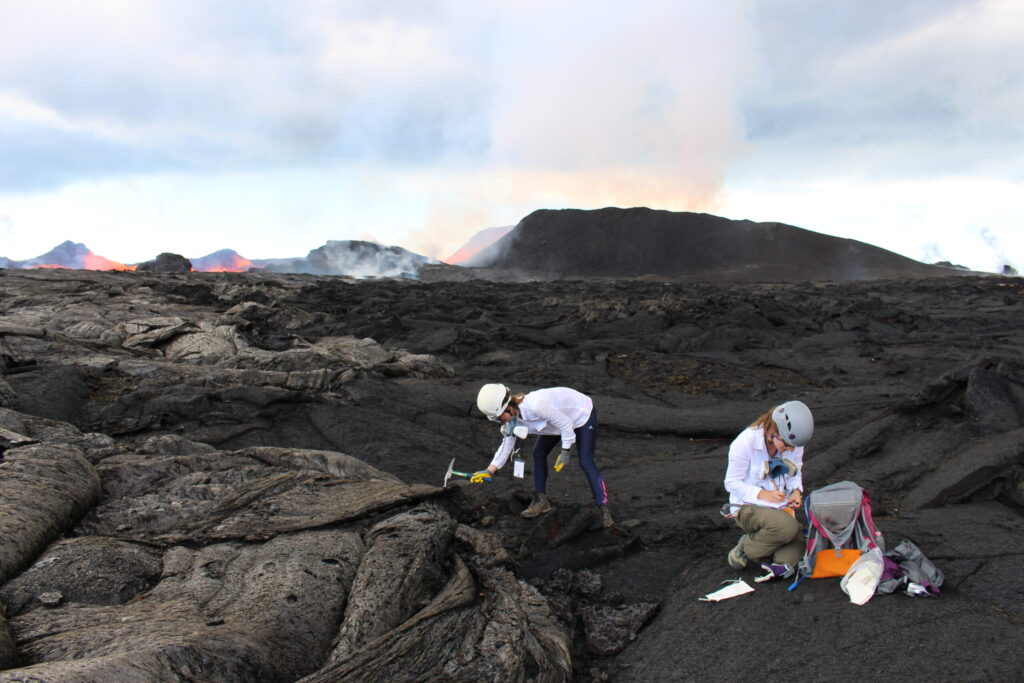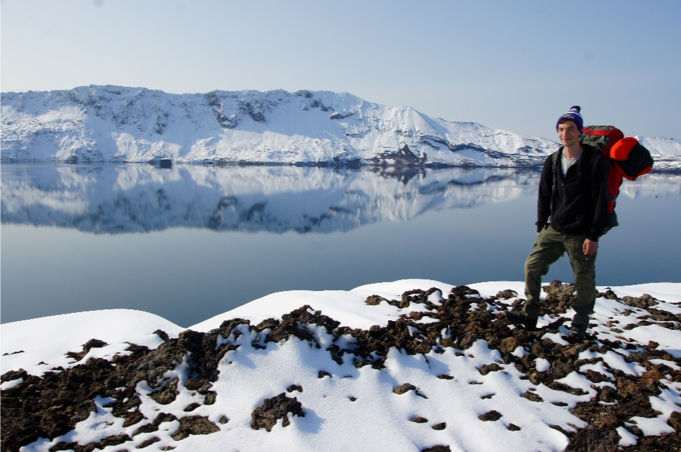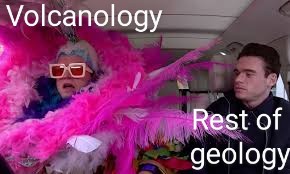

Welcome and a very belated Happy New Year to all! The cold that swept the UK in mid-February reminds us that winter leaves with a sting in its tail. However, we’ve been warmed by the massive success of the virtual VMSG conference that took place on 6 – 8 January 2021. In this newsletter you’ll find a celebration of the twin triumphs of vVMSG’s scientific and social sessions, colourful figures that spotlight challenges and progress to-date on EDI in our society, and an atlas showing our global community. We owe an enormous thanks to the conference organizers, conveners, and presenters for bringing that community together for a truly brilliant event.
The new year also brings change to the VMSG committee team. We bid farewell to Mike Cassidy (ECR Rep & Social Media), George Cooper (Field Trip Secretary), Sam Engwell (EDI Rep) and Jess Pugsley (Student Rep) who have contributed much effort and many talents to the work VMSG does. They will be sadly missed by continuing members! New committee members ready to carry the torch are Elliot Carter (Social Media), Jazmin Scarlett (EDI Rep), Pete Rowley (Field Trip Secretary), Ailsa Naismith (Newsletter Editor – hi!), and Claire Harnett (ECR Rep). Jenni Barclay will be blazing new trails in the role of Outreach & Public Engagement Officer.
Other goodies in this newsletter include announcement of a new journal, and not one, but two, student bursary reports – phew! Time to sit down and read with a nice cup of tea. – Ailsa Naismith
The annual winter conference is the flagship event of the VMSG and is traditionally when we get together in a convivial environment to present scientific findings and celebrate the outstanding contributions of colleagues. By summer 2020 it became apparent that the Covid-19 pandemic would not be going away as fast as we all had hoped, and the annual conference would have to be in a virtual format (vVMSG2021).
Our initial concerns re: the community suffering from ‘Zoom fatigue’ and not wishing to start the new year in front of a screen were unfounded, and your huge response to the call for abstracts required vVMSG2021 to have two parallel conference sessions. This was a first for the VMSG and set an ambitious conference agenda, all co-ordinated from the disparate homes of VMSG Committee members (spanning from Aberdeen to Cornwall and many points in between).
vVMSG2021 had a record number of delegates and from more countries than ever before (see below). The scientific standard of the keynote and oral and poster presentations was exceptionally high and undiminished by the pandemic. Replacing the networking and friendly atmosphere of the ‘normal’ face-to-face meeting was always going to be a challenge but we hope the virtual field trips to spectacular volcanic landscapes together with daily yoga sessions, a movie night, and quiz provided relaxing environments to meet colleagues old and new. To those who participated in VVMSG2021, we thank you for your engagement. If you couldn’t join us then a recording of the Annual General Meeting and many of the presentations are available on the new VMSG YouTube channel.
While so many of us remain confined to our homes, the spectacular footage of on-going eruptions at Etna, Kilauea and Volcan Pacaya reminds us of the powerful forces of nature which shape VMSG science and its relevance to our society. We continue to think of ways that we can engage with the VMSG community and the wider public in these challenging times. If you have ideas of workshops or virtual events (academic or social), please do get in touch. – Sally Gibson
How did it go? In a nutshell: marvellously. We owe a big thanks to our Treasurer Sami Mikhail who chaired the vVMSG2021 Organising Committee and to the Geological Society of London for co-ordinating the registration and abstract submission, and for hosting the conference on Zoom. We are hugely grateful to ThermoFisher, ZEISS and Nu for sponsoring VVMSG2021 and for their active participation in the conference.
vVMSG was a truly international affair: there were 409 registrations for the conference, representing more than 120 institutions from over 20 countries. Of the 409, 309 came from the UK, 44 from the rest of Europe, 4 from Africa, 20 from North America, 2 from the Caribbean, 13 from South America, and 17 from Asia. While the large number of delegates caused a few initial technical difficulties (we soon learnt that Zoom Breakout Rooms have a limited capacity) this was soon resolved and we hope no one was left stranded in cyberspace!

vVMSG’s scientific program was choc-full of fascinating and enriching science, conducted across two parallel sessions held via Zoom. The conference hosted nine thematic sessions each headed by a dedicated keynote. With themes as diverse as the East African Rift System to Volcanic Histories, we were freshly awed by the ingenious and inspired science that fellow magma-lovers shared over the three days.
It’s easy to feel blue after the conference has passed, but it’s also needless. You can get your fix of volcano science any time now that vVMSG talks have been uploaded to VMSG’s Youtube channel. If talking rather than listening is what you miss, the VMSG Discord server remains open – join it here.
Because a well-rounded volcanologist is a happy volcanologist, the vVMSG scientific program was attended by a number of social events. Each morning kicked (or rather, stretched) off with a yoga session with Celine Vidal. Lancaster University hosted a hot-headed quiz night on 8 January, and the night before saw explosions of laughter and plenty of ribbing with the awesome-awful movie ‘Apocalypse Pompeii’. Would the city be destroyed by the common volcanic hazard known as “heat surge”? Watch the full movie here to find out – and get your popcorn ready!
The pre-conference field trip, “Exploring scales of lava emplacement in Namibia, Skye and Mull”, took place on 7 January and was run by Jess Pugsley and John Howell of the University of Aberdeen. You can watch the whole field trip via YouTube here.
Congratulations to our vVMSG prize winners! Professor Ed Llewellin (Durham) was awarded the Thermo Fisher VMSG Award, given to an individual who has made a significant contribution to our current understanding of volcanic and magmatic processes. Ailsa Naismith (Bristol) won the Willy Aspinall Award for her 2019 paper on eruption frequency patterns at Volcán de Fuego. Dr Jamie Farquharson (Miami) was awarded the Zeiss Post-doctoral Keynote Award, and gave an invited keynote presentation for his winning abstract on assessing rainfall-induced volcanic hazard.
Student presentations were of outstanding quality at vVMSG. Matthew Varnam (Manchester) won the Bob Hunter Prize for the best oral presentation given by a student, while Adam Cotterill (UCL) was the winner of the Geoff Brown Prize for best student poster presentation. Kirsten Stephens (Penn State) achieved the Bob Hunter Runner-up Prize, and Elena Jones (Hull) received the Geoff Brown Runner-up Prize. All winning talks can be found on the vVMSG webpage.
The VMSG is committed to ensuring Equality, Diversity and Inclusion in all of our activities and since 2018 the Committee have made positive steps to address these issues. We are currently monitoring our progress using the EDI framework established by the UK Science Council and the Royal Academy of Engineers and details of this were preesented at the Annual General Meeting in January 2021. This shows that while we have made very good progress we can and should do more. A major EDI initiative of the VMSG Committee last year was to host a series of discussion panels, organised by Jenni Barclay and Mike Cassidy.
On 18th December 2020, VMSG held the third of three panel events on how opportunity is split within our community. These events recognized historic biases and inequalities in the geosciences, and provided a space for people to share ideas on changes we can make to allow all our members to share their talents, regardless of background. In this final event, seasonally titled “All I want for Christmas is some action on diversity in Geoscience”, we heard from our President Sally Gibson on progress in VMSG in recent years. We also listened to Jo O’Leary, Head of EDI at UKRI, talk about aspirations towards a system where ‘everyone has the opportunity to flourish’. A recording of the panel event can be found here. A summary of the talk was presented at vVMSG; its recording can be found here.
The conference was able to give presentations to all those who asked for them. We’ve also seen above the effects of going virtual on including people from around the world. The bar graph below shows the breakdown of male vs. female presenters by presentation type, while the pie chart shows the breakdown of conference delegates by career stage. Cheeringly, 42% of the 409 were MSc, undergraduates, and concessions – very encouraging to see how many new and aspiring volcanologists attended.
Future advances in EDI include meeting with other special interest groups within the Mineralogical Society and Geological Society of London to discuss how we can make progress in both collecting EDI-related data and taking actions on the data. There will also be actions related to issues raised in vVMSG’s student and ECR forums about UKRI and COVID. Watch this space – or better, the Twittersphere: @vmsg_uk. – Jazmin Scarlett
This edition we hear two voices from opposite ends of the Earth: Iceland and Kīlauea.
I am very grateful for my VMSG bursary, allowing me to attend AGU2020 to present my PhD work on olivine-hosted melt inclusions in a special session, “Multi-disciplinary investigations of the 2018 Kīlauean eruption”. Despite the inevitable late night (as Hawai’i is 11 hours ahead of the UK), it was a really productive session. The work I was presenting uses the strong dependence of H2O and CO2 solubility on pressure to investigate the depths at which olivine crystals erupted in 2018 crystallized (through the analyses of these volatile species in melt inclusions trapped within these crystals). This work demonstrates that the dominant fissure in the 2018 eruption (Fissure 8) was supplied from 2 distinct reservoirs beneath Kīlauea’s summit (at ~1-2 km depth, and 3-5 km depth). Interestingly, in work published so far, the geophysical community have emphasized the importance of the upper reservoir in terms of dominating geodetic signals during the eruption. Thus, the scheduled live-chat provided a really interesting opportunity for me to ask questions to geophysicists about whether they also saw signals indicating the involvement of a deeper source. It also started some lively discussion about the exact depth of the magma transport path between Kilauea’s summit and the eruption site >30 km downrift. Overall, it provided a great opportunity to get people working on different data streams (geodetics, seismics, hazard perception, gas signals, petrology) to discuss their findings, and to network amongst each other. AGU also provided a way for me to advertise my paper on this topic, which was accepted in G3 a week before. By posting the accepted manuscript on EarthArxiv, ~200 people downloaded it in the 2 weeks of AGU.
AGU2020 was also the first time I was involved in convening a session (the IAVCEI “Dynamics of Volcanic Plumbing Systems” session). As well as providing good networking opportunities with the other convenors and participants in our session, this experience made me appreciate how much work it is to convene a session, particularly at a virtual conference where there is constant fear of technological failure! In addition to the live chat scheduled by AGU, Deepak Garg (my fellow convenor) and I also scheduled a poster walk, where people could give a short 1-2 minute flash talk to advertise their poster. We got a lot of good feedback from ECRs, who were pleased to have an opportunity to direct people towards their poster, which made it worth all the stress (AGU had actually disabled my account for some reason in the 24 hours leading up to our poster walk!).
I also used the bursary to attend a course run by the geochemical society “ Geochemical Society Fall Workshop: Thermodynamic Modeling of Magmatic Processes with alphaMELTS 2” in the weeks leading up to AGU (this workshop was originally scheduled to be in person at Goldschmidt 2020, but was delayed and moved to a virtual format due to COVID). This provided an introduction to the new Matlab and Python tools developed by Paula Antoshechkina, which are a game changer in terms of running MELTS on a windows PC (and doing iterative calculations). The skills I learn in this workshop will be really important to write up my final PhD paper on more evolved samples from the 2018 eruption. – Penny Wieser

As part of my PhD research on flow direction indicators in high-grade rheomorphic ignimbrite I am investigating the upper surface folding in high-grade tuffs. At several localities in my main field area on Pantelleria, Italy, the upper vitrophyre exposes spectacularly developed folds that vary in size and complexity with the fold hinges being aligned subparallel to the other shear direction indicators (elongation lineations). Key information required for understanding the initial folding stages, however, are missing or inaccessible and a different rheomorphic deposit is needed, where such early folds have been preserved.
Therefore, I was keen on investigating the surface folding in the 1875 eruption at Askja, Iceland, the only place to our knowledge where such structures are well exposed and rather easily accessible. As rental costs for a 4WD in Iceland exceeded my funding, my field assistant Dr David Finn and I went to Askja via car sharing and public transport which was incredibly simple and unproblematic. Besides documenting the early folding stages with photographs and structural measurements, we were able to generate a digital elevation model of the caldera wall to investigate the eruption related tilting.
The rather unpredictable and constantly changing weather conditions that we experienced at Askja are well summarised by the English explorer Edward Delmar Morgan, who noted during his expedition to Askja in August 1881, less than 6 years after the devastating 1875 eruption, “Our temperature observations varied from 20°C in the sun to -5°C at night and beside exceptions of severe wind (>100 km/h wind gusts), thick fog, hail and snow the weather was magnificent.”
I am very grateful to the VMSG Travel Bursary Award for providing me with funds to make this fieldwork possible. The award greatly extended the timeframe that was needed to undertake the detailed mapping and descriptions. – Gregor Hahn

You may have heard through the grapevine about a journal launch. It’s true! ESCubed: Earth Science, Systems and Society is a new not-for-profit journal by the Geological Society of London aiming to publish topical research across the breadth of geosciences. Its mission statement is crystal clear: “encouraging inclusivity and diversity in publishing, engaging directly with early career researchers, embodying principles of openness and transparency in science, and presenting a forward-looking perspective on geoscience and related disciplines”. And can’t we all get behind that.
Explore the journal through its tantalising new website here. There are three special issues currently welcoming abstract and manuscript submission: Hazards and Society (here), Sustainability in the Extractive Industries (here), and Earth Sciences and the Race to Net Zero (here). Happy reading and writing!
EGU General Assembly – online (19th – 30th April 2021)
Cities on Volcanoes 11 – Crete (14th -18th June, 2021)
Goldschmidt 2021 – Lyon (4th-9th July 2021)
AGU – New Orleans (13th – 17th Dec 2021)
IAVCEI 2022 – New Zealand (20 – 24th Jan, 2022)
For those who made it through to the end, here’s an irrestible meme. Have fun with it!
